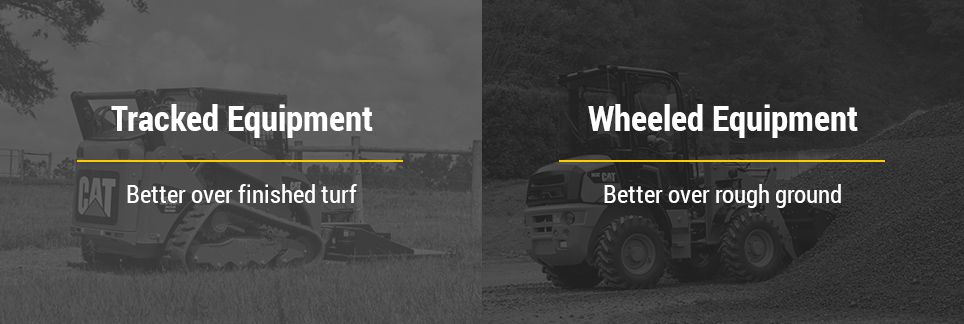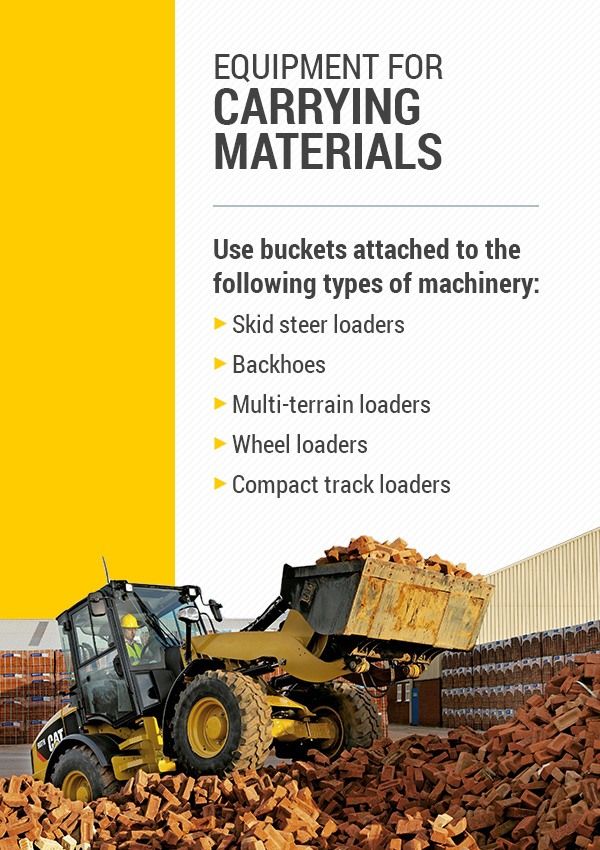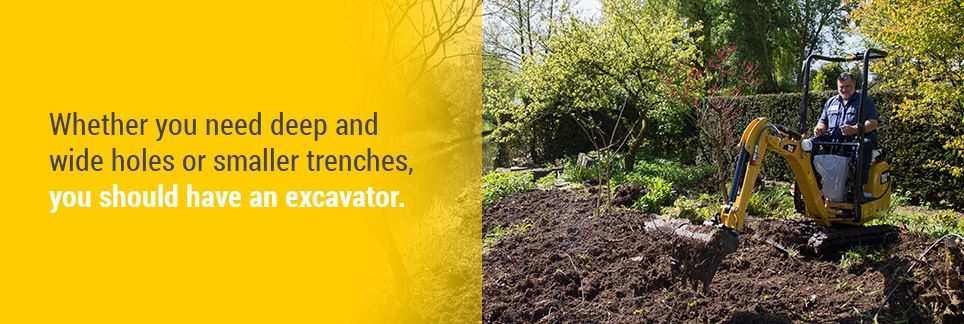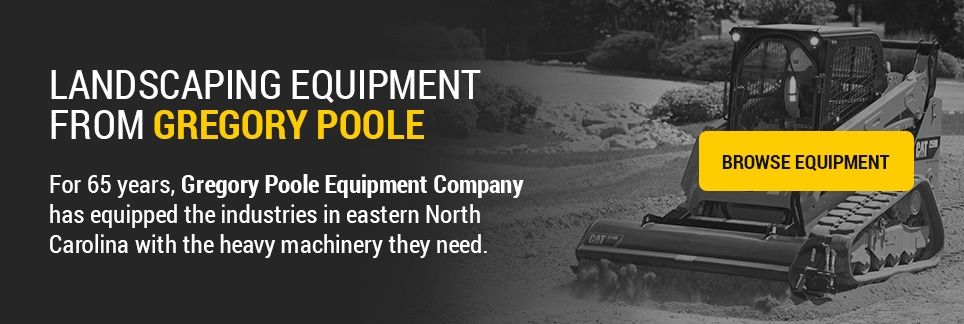Types of Equipment Used in Landscaping
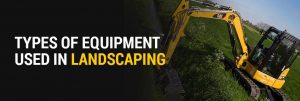
The landscaping industry makes use of heavy equipment for a variety of earthmoving jobs. To succeed in the field, you need machinery that stands up to daily use in a wide range of conditions. Though you may encounter all types of landscaping equipment, not every piece will suit the work you do. Find out more about the variety of machinery you can choose from to make the best choice for your business needs.
Choose the Best Landscaping Equipment
Your business will have different needs from others. To determine which landscaping tools and equipment your company needs, you must examine the work your crews do and pair those with the appropriate machinery. In many instances, you will need more than one type of equipment, but the size of the machine also makes a difference. Using oversized equipment could damage the land or not fit onto the property that your crew services. To choose the right type of machinery, you’ll need to consider:
1. Equipment Size
The equipment must fit into the area you need to work on while having room for maneuvering around the space. Machinery that is too small will be inefficient, and your crews will need more time to finish the job. If the equipment cannot move around the job site as needed, you won’t be able to complete the task at all.
For landscaping companies that typically tend to smaller lawns and lots, smaller devices such as compact track loaders, mini excavators or skid steer loaders may be better solutions. Projects that cover large lots or massive land clearing may require more heavy-duty equipment such as wheel loaders, excavators or backhoe loaders.
2. Machine Capacity
How much earth will your crews need to move? The answer will help you choose the best machinery with a bucket capacity for getting the job done as efficiently as possible. Heavy landscaping equipment, such as backhoes and wheel loaders, can move more earth than smaller models, such as skid steer loaders. These machines will serve you better for clearing or grading large plots of land.
3. Land Type
Whether you’ll need wheeled or tracked equipment depends on the type of ground you need to use it on. Tracks evenly distribute the equipment’s weight over the long tracks, reducing the amount of pressure the machine puts on the ground. Tracks work better if you need to drive over finished turf to minimize damage to the ground. This type of undercarriage also allows for better traction in wet conditions, uneven ground or loose sand.
Wheeled equipment drives better over rough ground or dirt. More substantial machinery will leave bigger imprints in the land, depending on the terrain. As a landscaper, choose wisely to preserve the surrounding area while doing your job.
Landscaping Tools and Equipment Checklist
You have several options when selecting equipment used in landscaping. Use this checklist to ensure you have the right tools you need for your work.
1. Tools for Digging
If you need to dig, the size of the hole you need and the amount of dirt you need to remove will dictate which equipment you choose. The size of the bucket affects how much soil you can take out of the ground at once. Larger machines, such as excavators, have more voluminous buckets that can dig deeper holes faster.
Essential landscaping equipment for digging includes the following:
- Skid steer loaders
- Compact track loaders
- Multi-terrain loaders
- Backhoe loaders
- Excavators
- Wheel loaders
2. Equipment for Loading
Loading machines can pick up dirt, rocks and more and load them into a truck. As with digging tools, the bucket capacities vary based on the equipment’s size. If you need to clear land and remove the cleared dirt, loaders will be vital pieces of equipment.
The following pieces of machinery excel for loading tasks:
- Skid steer loaders
- Multi-terrain loaders
- Wheel loaders
- Backhoe loaders
3. Tools for Grading Land
Blades attached to industrial landscaping equipment allow you to push the dirt around for grading land. You can order different sizes of blades to increase the width of the ground you need to level with sizes typically starting at 75 inches. Choosing a non-metallic-edged attachment increases the uses of the equipment for snow clearing in the winter.
Equipment that can accommodate grading blades include:
- Compact track loaders
- Skid steer loaders
- Multi-terrain loaders
- Backhoes
4. Equipment for Carrying Materials
Carrying materials around the job site becomes more comfortable when you have heavy-duty equipment that can effortlessly do the task for you. Buckets for light materials such as mulch, wood chips and soil can help your landscaping chores finish faster because workers do not have to manually push small wheelbarrows of these materials to where they need them. A 72-inch-wide light material bucket should hold about a cubic yard of material.
For moving landscaping rocks or wet sand, you will need a sturdier bucket and equipment to lift the heavier load. Multipurpose buckets can support larger materials. When lifting materials, though, never fill the bucket with a higher weight than the machinery can handle.
For carrying materials, use buckets attached to the following types of machinery:
- Skid steer loaders
- Backhoes
- Multi-terrain loaders
- Wheel loaders
- Compact track loaders
Heavy Equipment for Landscaping
Landscaping equipment essentials include devices that can dig, move materials, load and grade land. These machines come in sizes that range from compact models to heavy-duty designs for large plots. Discover the distinguishing characteristics of backhoes, compact track loaders, excavators, skid steer loaders and wheel loaders to find out which will best work for your landscaping projects.
1. Backhoe Loaders
If your work demands on-the-spot versatility and changing tasks in minutes, you may require a backhoe for your work. These workhorses can accomplish twice the number of jobs due to their two-sided design. On one side, you have a backhoe bucket that allows you to dig or backfill material. A loader on the other end of the backhoe makes moving the dirt that you removed from the hole a simple task.
At Gregory Poole, we offer Cat® backhoes that consistently push the technological edge to help make your jobs easier. Options include low-effort joystick controls that provide operator feedback during digging while reducing the effort needed. Load-sensing hydraulics improve this machine’s efficiency. The hydraulics operate at a cooler temperature, which reduces wear on the moving parts and increases fuel efficiency for the backhoe.
Additions to Cat backhoes that also help improve your operations include a loader that returns quickly to the dig position with a simple lever pull. You spend less time waiting on the loader bucket and more time getting work finished. On the backhoe side, you can increase the reach and dig depth by 4 feet with the addition of an optional E-stick.
With standard dig depths starting at 14.3 feet, Cat backhoes are preferred since they can handle larger digging projects than a skid steer loader or compact track loader can accomplish.
2. Compact Track and Multi-Terrain Loaders
Track loaders give you more traction when the ground is soft, wet or uneven. Compact track loaders offer versatility in a small package. If you need to operate on land that requires a machine with lower ground pressure, such as turf, opt for a multi-terrain loader.
You don’t need to stop your landscaping work when it rains. Track loaders can drive over the muddy or wet ground without tearing up the terrain as wheeled equipment would.
These compact machines have similar uses to skid steer loaders. Among the equipment used for landscaping, compact track and multi-terrain loaders are some of the most versatile. When you have jobs that require a small-sized piece of machinery and less damage to the land, select a multi-terrain loader. If you need a small size and maneuverability in wet or muddy conditions, choose a compact track loader.
Like our backhoes, we offer high-quality Cat compact track and multi-terrain loaders. Rated operating capacities for these machines range from 2,010 pounds to 3,560 pounds. With such wide ranges of loads, you can find a model to carry the soil, mulch or other landscaping materials you need to move.
3. Excavators
Full-sized excavators are designed for digging large holes or trenches, while the compact ones are for small lots. When it comes to tools and equipment used in landscaping for digging, excavators excel at the task. Cat excavators have a design specially to handle digging. Whether you need deep and wide holes or smaller trenches, you should have an excavator.
For serious digging projects, such as creating a hole for a pool or massive water feature, choose a large hydraulic excavator. Some of our Cat excavators can achieve a digging depth of 24.67 feet. For smaller projects like digging out a planting bed or creating the planting hole for a tree, use a mini excavator, which reaches depths of just over 5 feet for even the most compact models.
Mini excavators are ideal go-anywhere tools when you need a powerful digging machine on tracks. The track undercarriage carries the excavator to any part of the job site, even over unfinished areas of land that still have rocks, mud or loose dirt. Despite their size, mini excavators feature powerful Cat engines that start at 13 net horsepower and an increase in engine output from there.
If you need a digging tool, excavators will fulfill your needs. Choose mini excavators for reaching tight spaces or select larger models when you need to get significant amounts of dirt moved in a short time.
4. Skid Steer Loaders
Though small, skid steer loaders are a favorite option for landscapers due to their easy-to-maneuver design and wide range of tools that attach to them. Choosing Cat skid steers gives you extra safety from flying debris with an enclosed operator cab, versatility with multiple attachment options, and advanced power and hydraulics systems for improved operations.
While skid steer loaders closely resemble compact wheel loaders, the former have much smaller turning radii. If you need a compact solution to work in a tiny space, a skid steer loader will serve you better than a compact wheel loader. Pairing with their small size, these loaders do not have extra room for operator entry stairs. Instead, to enter the cab, the operator steps over the front attachment. Many attachments will have a guard in place to protect both the tool and the operator.
Cat skid steer loaders have several features to set them apart from others. A rear-facing camera makes backing up safer, and up to 50 different operators can set preferences inside the cab for controls and seating.
Engine powers on these machines range from 74.3 to 110 horsepower, and load capacities in our Cat models go up to 3,700 pounds. With such power and strength, you will undoubtedly find a use for these skid steer loaders to move soil, dig, grade land or load dirt.
5. Wheel Loaders
Some tools and equipment in landscaping have only a handful of options that vary slightly in size and power. Other machines offer a much broader range of options. Wheel loaders, like excavators, come in a variety of sizes, from compact to large.
For smaller landscaping jobs, you can use a compact or small wheel loader. Even the most compact models of wheel loaders take up more space than skid steer loaders, and they need more room to turn around.
Cat wheel loaders include specialty features to improve efficiency and productivity, one of which is creeper control. This control on the machine adjusts the speed and engine RPM based on the effort needed. For example, using a snowblower attachment requires slower speed but faster engine revolutions. These loaders also have controls that regulate the hydraulics and drivetrain power to specific jobs. For example, if you need to use the wheel loader to fill a dump truck with debris or dirt, the engine will send more power to the hydraulics. Lifting forklifts will require more finesse in moving the attachment, so the system will slow speeds as needed.
All Cat wheel loaders offer these same features, so whether you choose compact, small or large models, you still get the benefit of better operation of any attachment. For landscaping, you can use the biggest wheel loaders for moving large piles of dirt, but you can shift smaller loads on tinier lots with a compact model. With the range of options of wheel loaders, finding the indispensable option your landscaping company needs will be easy.
Your Source for the Best Commercial Landscaping Equipment
For over 65 years, Gregory Poole Equipment Company has equipped the industries in eastern North Carolina with the heavy machinery they need. We want to be your source for professional landscaping equipment.
Your landscaping business deserves top-quality Cat equipment. Backhoes, skid steer loaders, excavators and more are investments that you will want to last. Trust the Caterpillar® brand for your equipment and support from Gregory Poole to help your company thrive. Browse through our tools and equipment needed for landscaping to find the machinery you need to get the job done right and efficiently.


